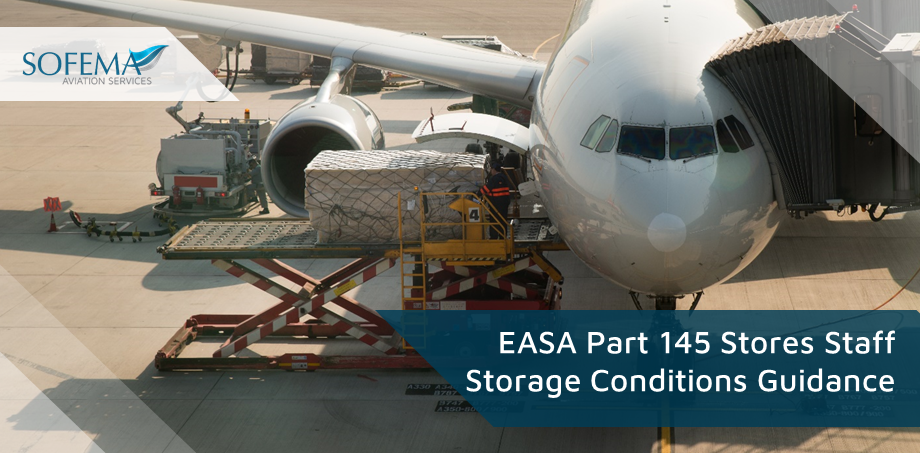Sofema Aviation Services (SAS) www.sassofia.com considers the key elements involved in a fully compliant EASA Part 145 Stores Staff with a focus on cautions, general considerations, and best practices (for additional guidance refer to CAP 562 Leaflet D40
Introduction
The effectiveness of the store process in an aviation maintenance context significantly hinges on the training and competence of the personnel. A well-structured training program, continuous competence development, and adherence to best practices ensure that store operations contribute positively to the overall safety and efficiency of aviation maintenance activities.
The stores’ process is a critical component of aircraft maintenance and safety. The efficacy of the store process is heavily dependent on the training and competence of the personnel involved.
- Ensuring that staff are well-trained and competent is not just a regulatory requirement but a fundamental aspect of maintaining the highest standards of aviation safety and efficiency.
- Personnel must be proficient in the processes and procedures of the store, including inventory management, parts inspection, documentation, and issue and return of items.
- For handling specialized items such as hazardous materials, electrostatic-sensitive devices, and aviation-specific parts.
- Standard Operating Procedures (SOPs): Documented SOPs guide store personnel in daily operations and ensure consistency and compliance.
General Storage Conditions
- Clean and Well-Ventilated Premises: Ensure that storage areas are clean, and well-ventilated, and maintain an even dry temperature to minimize condensation.
- Temperature and Humidity Control: Regularly monitor temperature and relative humidity using a hygrometer. Adhere to manufacturer-specified conditions.
- Protective Materials: Use appropriate protective materials such as Vapour Phase Inhibitors (VPI), protective oils, fluids, compounds, and desiccants to prevent corrosion and damage.
- Racks and Bins: Prefer open racks for free air circulation. Use painted metal, polyethene, or corrugated plastic bins for small parts.
- Rotation of Issue: Follow a strict rotation method – issue older stock before newer stock, especially important for perishable goods.
- Storage Limiting Periods: Observe manufacturer-imposed storage limiting periods. Withdraw parts for checking or overhaul after the expiry of these periods.
- Flammable Materials: Store in isolated stores, complying with safety regulations.
- Segregation of Stock: Segregate materials to prevent cross-contamination (e.g., acids away from raw materials).
- Packaging and Handling: Use appropriate materials and methods for packaging. Handle materials, especially sensitive ones like high-strength aluminium alloys, with care to avoid damage.
- Specific Storage Conditions for Materials and Parts
- Ball and Roller Bearings: Store in original wrappings, in dry, clean conditions. Avoid spinning bearings in an unlubricated condition.
- Aircraft Batteries: Store in a “fully charged” condition in a cool, dry, well-ventilated place. Regularly check and recharge.
- Braided Rubber Cord: Store in a cool, dark place with controlled temperature and humidity. Observe the storage limiting for 4 years.
- Compressed Gas Cylinders: Store in well-ventilated areas, away from direct sunlight and dampness. Keep full and empty cylinders separate.
- Electrical Cables: Store reels horizontally to prevent cable damage.
- Fabric: Store in dry conditions away from direct sunlight and heat sources.
- Forgings, Castings, and Extrusions: Store separately on racks. Protect high-strength aluminium alloys from stress corrosion.
- Instruments: Store in a dry, even temperature, in original packaging. Regularly check desiccants.
- Pyrotechnics: Store in a dry, well-ventilated building at a constant temperature. Regularly proof-test as per manufacturer’s specifications.
- Rubber Parts and Components: Control storage temperature, humidity, and light exposure. Avoid deformation and contamination.
- Sheet, Bar, and Tube Metal: Store in a manner that prevents damage and corrosion. Inspect temporary protectives regularly.
- Best Practices
- Strict Adherence to Manufacturer’s Instructions: Always follow the specific storage guidelines provided by the manufacturer.
- Regular Inspections and Maintenance: Periodically inspect stored items for signs of damage, corrosion, or other wear.
- Staff Training and Awareness: Ensure all personnel handling materials are aware of and trained in best storage practices and handling procedures.
- Safety and Compliance: Adhere to all safety regulations and guidelines to prevent accidents and ensure compliance with legal requirements.
EASA Part 145 Stores General Cautions
- Avoid Mixing Incompatible Materials: Store materials in a way that prevents harmful interactions.
- Handle with Care: Especially sensitive materials like high-strength alloys or delicate parts like bearings and instruments require careful handling.
- Beware of Environmental Factors: Temperature, humidity, and light can significantly impact the quality and usability of stored materials.
- Adhering to these guidelines will ensure the proper storage and handling of aeronautical supplies, maintaining their quality and integrity while ensuring safety and compliance with regulatory standards.
Adhering to best practices and continuous professional development are key to ensuring the safety and efficiency of aviation maintenance activities. The storage process is a fundamental component of aircraft maintenance and safety, heavily reliant on the skills and knowledge of the personnel involved.
Next Steps
Follow this link to our Library to find & Download related documents for Free.
Sofema Aviation Service www.sassofia.com and Sofema Online www.sofemaonline.com provide multiple EASA and FAA compliant Stores & Logistics Courses -see the applicable website or email team@sassofia.com
Tags:
Aircraft Maintenance, Aviation Maintenance, best practices, CAP 562 Leaflet D40, Competence Development, EASA Part 145, EASA Part 145 Stores Staff, general considerations, hazardous materials, Inventory Management, parts inspection, personnel, SAS blogs, Standard Operating Procedures (SOPs), Stores Staff, Training Program




